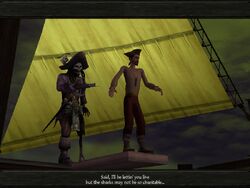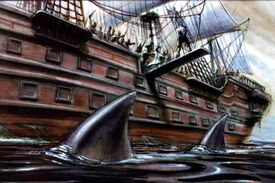| For other uses, see Walk the Plank (disambiguation) |

Elizabeth Swann forced to walk the plank aboard the Black Pearl.
- "Walk the plank!"
"What did the bird say?!" - ―Cotton's parrot and Jack Sparrow
Walking the plank, or simply walk the plank, was a term and method of execution practiced on special occasions by pirates, mutineers, and other rogue seafarers. For the amusement of the perpetrators and the psychological torture of the victims, captives were sometimes bound so they could not swim or tread water and forced to walk off a wooden plank or beam extended over the side of a ship over the water, intended to lead to one's death. This method was most notably used by Captain Hector Barbossa, when he forced Captain Jack Sparrow and Elizabeth Swann to walk the plank aboard the Black Pearl.
History[]

Jolly Roger forces his victim to walk the plank.
- "Get walking!"
"But..."
"Walk the plank!"
"Just like a real pirate!" - ―Hector Barbossa and Jack Sparrow
When the British Royal Navy forces led by Admiral Lawrence Norrington captured the infamous pirate Captain Edward Teague and his young son Jack Sparrow, they were sentenced to death by walking the plank. The execution was sabotaged by a British crew member Joshamee Gibbs who tied the pirate's hands only loosely, allowing him to free himself and attack the admiral.[1]
At the beginning of the quest for the Treasure of Cortés, the crew of the Black Pearl raised a mutiny against Jack Sparrow, electing Hector Barbossa as their new captain and forcing Jack to walk the plank, leaving him stranded on Rumrunner's Isle.[2] During their pursuit to lift the curse of the Aztec Gold, Barbossa and his pirates fell into a trap orchestrated by the Greek demigod Palaimon. As they dueled on the main deck of the Black Pearl, Barbossa managed to corner Palaimon on the plank, and then cut it with his sword, sending his opponent into the depths of the sea.[3] A decade after Barbossa's mutiny, Jack Sparrow and Elizabeth Swann were forced to walk the plank by Barbossa off the coast of the same island.[4]
During the War of Jolly Roger the infamous undead captain Jolly Roger was known to make the imprisoned pirates walk the plank.[5]
At the beginning of the search for the Dead Man's Chest, when the crew of the Black Pearl complained to Jack about the lack of honest pirating, Jack asked them if they thought he wasn't serving their best interests as captain. Cotton's Parrot responded by squawking "Walk the plank" to which Jack reacted by pulling out his pistol and threatening to shoot the bird.[6]
Behind the scenes[]

Simon Murton's artwork for Pirates of the Caribbean: The Curse of the Black Pearl.
- "I'd been standing on that plank for two days, with nothing but air around me and water below. I was absolutely petrified. The plank is quite narrow like a diving board, so it bounces up and down when you move and even when you just stand there. When it came time to jump off the board, Gore told me I didn't have to do it, that he'd have my stunt double, Sonia, do it. I said, 'I've been standing up here for two days! Do you really think I'm not going to jump off this thing?' So I jumped in that long dress. I was terrified. I asked Gore if he wanted me to scream and he just said, 'Whatever comes out.' I screamed my head off. The only interesting bit was when I hit the water and the dress went over my head, I showed off my knickers. I was so girly, but I was proud of myself. I don't know what I must have looked like."
- ―Keira Knightley
- Walking the plank first appeared in Pirates of the Caribbean: The Curse of the Black Pearl through the 2003 video game,[7] junior novelization,[8] as well as the film itself.[4]
- While filming The Curse of the Black Pearl, Johnny Depp (Captain Jack Sparrow) and Keira Knightley (Elizabeth Swann) spent almost three entire shooting days standing at the end of a long two-by-four, protruding from the side of the Black Pearl, 15 feet over the rolling ocean waves. No stunt person, no body double, no look-alike or dead ringer need apply; it was Johnny and Keira balancing at the end of that plank. Knightley was particularly vocal about it, admitting to be "absolutely petrified" by the experience. At the end when the time came for her to jump off the plank, director Gore Verbinski offered to use her stunt double (Sonja Jo McDancer), Keira insisted on doing it herself saying, "I've been standing up here for two days, do you really think that I'm not going to jump of this thing?" Despite her initial fear, Knightley came up smiling, unscathed by the experience.[9][10]
- "It's pure evil to make a Captain walk the plank of his own ship, twice in one lifetime. No good can come of it."
- ―Jack Sparrow
- In Ted Elliott and Terry Rossio's first screenplay draft for Pirates of the Caribbean: The Curse of the Black Pearl, Elizabeth refused to walk the plank, so she was thrown overboard by Hector Barbossa's crew.[11]
- In Dead Man's Chest, when Captain Jack Sparrow asks his crew if they think that he's not serving in their best interests as captain, Cotton's Parrot squawks "Walk the plank." But in the film's novelization and the movie storybook, the bird squawks "ABANDON SHIP!"
- Although forcing captives to walk the plank has been a motif of pirates in popular culture since the 19th century, few instances are documented in real-world history. While the earliest documented record of the phrase "walk the plank" was recorded in the second edition of English lexicographer Francis Grose's Dictionary of the Vulgar Tongue, which was published in 1788, a mutineer named George Wood confessed to his chaplain at London's Newgate Prison that he and his fellow mutineers had sent their officers to walk the plank in 1769. In 1829, pirates intercepted the Dutch brig Vhan Fredericka in the Leeward Passage between the Virgin Islands, and murdered most of the crew by making them walk the plank with cannonballs tied to their feet, an account later documented by naval historians like David Cordingly.
- "Walking the plank is, as far as I'm concerned, a complete myth. In all my research pirates, I found one account of walking the plank. The thing about walking the plank is that it appears in Peter Pan. It then appears in all the famous movies. Douglas Fairbanks, Jr., Errol Flynn. Everybody's seen the movies, and therefore, everybody assumes pirates made people walk the plank."
- ―David Cordingly
- Despite the likely rarity of the practice in actual history, walking the plank entered popular myth and folklore via depictions in popular literature. Robert Louis Stevenson's 1884 classic Treasure Island contains at least three mentions of walking the plank, including at the beginning where Billy Bones tells bone-chilling stories of the practice to Jim Hawkins. The concept also appears in J. M. Barrie's Peter Pan, where Captain Hook's pirate crew helped define the archetype aboard the Jolly Roger, with the Disney song "The Elegant Captain Hook" using the threat as one of the lyrics.
Appearances[]
- Climb Aboard if you Dare!: Stories from the Pirates of the Caribbean (Mentioned only)
- Jack Sparrow: Silver (Mentioned only)
- Jack Sparrow: Sins of the Father
- Legends of the Brethren Court: Day of the Shadow (Mentioned only)
- Pirates of the Caribbean: The Curse of the Black Pearl (video game) (First appearance) (First identified as walk the plank)
- Six Sea Shanties: Strangers Bearing Gifts
- Pirates of the Caribbean: The Curse of the Black Pearl
- Pirates of the Caribbean Online
- The Sidekick! (Mentioned only)
- Pirates of the Caribbean: Dead Man's Chest (Mentioned only)
- Pirates of the Caribbean: Tides of War (Mentioned in flashback(s))
- The Brightest Star in the North: The Adventures of Carina Smyth (Mentioned only)
- Sea of Thieves: A Pirate's Life (Mentioned only) (Non-canonical appearance)
Sources[]
- An Epic At Sea: The Making of Pirates
- Below Deck: An Interactive History Of Pirates
- Pirates of the Caribbean: The Visual Guide
- Pirates of the Caribbean: The Complete Visual Guide
External links[]
Notes and references[]
- ↑ Jack Sparrow: Sins of the Father, pp. 109-115
- ↑ Pirates of the Caribbean: The Curse of the Black Pearl (video game)
- ↑ Six Sea Shanties: Strangers Bearing Gifts
- ↑ 4.0 4.1 Pirates of the Caribbean: The Curse of the Black Pearl
- ↑ Pirates of the Caribbean Online
- ↑ Pirates of the Caribbean: Dead Man's Chest
- ↑ Pirates of the Caribbean: The Curse of the Black Pearl (video game)
- ↑ Pirates of the Caribbean: The Curse of the Black Pearl (2003 junior novelization), pp. 88-89
- ↑ An Epic At Sea: The Making of Pirates
- ↑ Pirates of the Caribbean presskit, accessed Dec 9, 2006
- ↑ Wordplayer.com: PIRATES OF THE CARIBBEAN: THE CURSE OF THE BLACK PEARL by Ted Elliott & Terry Rossio
